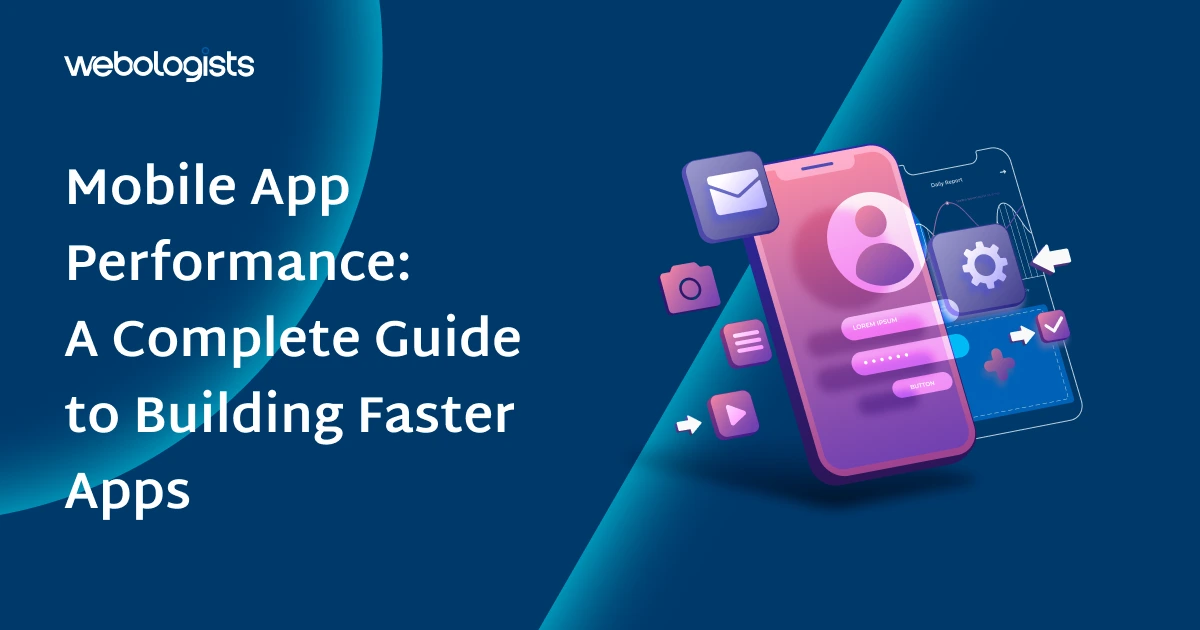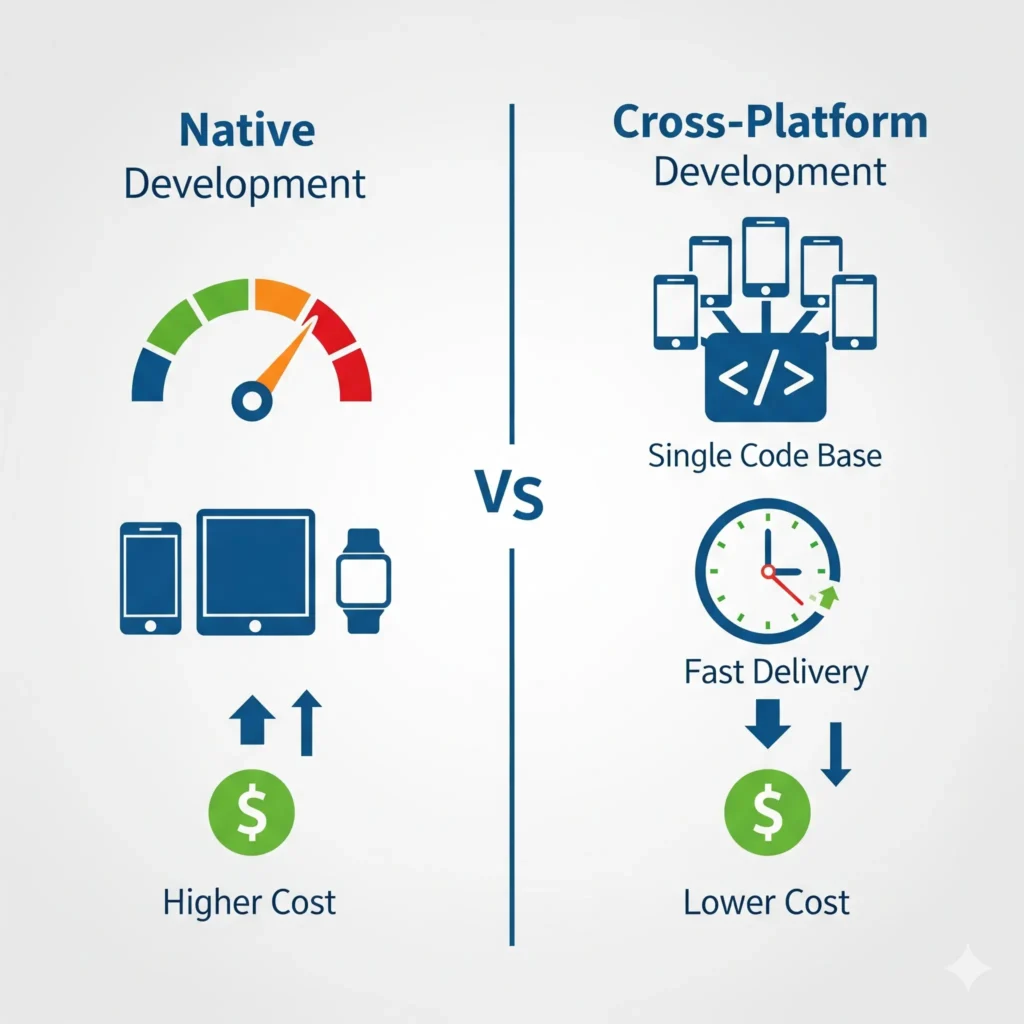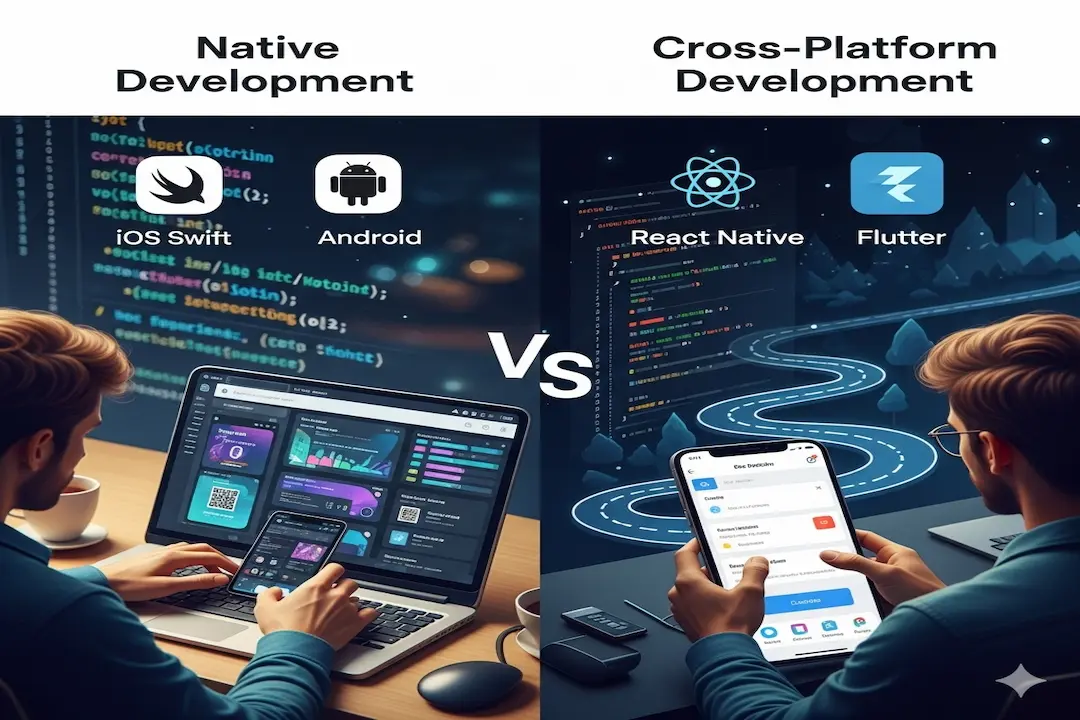
Do you know what makes your favorite mobile applications so efficient? Are you an entrepreneur with an innovative application idea facing a critical decision: selecting the optimal development strategsy? How you build your mobile application isn’t a minor implementation detail. It’s a fundamental decision that will impact user experience, available features, development costs, and long-term scalability. Make the right choice, and you will establish a solid foundation for a successful digital product. Neglect the critical nuances, and your development process may become complicated, expensive, and ineffective. For businesses looking to develop smartphone apps, this initial strategic assessment is essential.
The choice between native and cross-platform mobile app development is not purely technical; it shapes the app’s trajectory. It influences launch speed, user satisfaction, and even recurring maintenance expenditures. For an outstanding mobile development consultancy, a thorough grasp of these nuances is indispensable. Let’s thoroughly examine these two main approaches to furnish you with the insight necessary to make a well-informed decision for your mobile application.
Table of Contents
Understanding Mobile App Development Approaches

Before comparing the advantages and disadvantages, a basic understanding of each mobile application development method is helpful. Imagine constructing a home: would you prefer a custom house designed for a specific lot or a flexible modular home ready for assembly? Many app development company services provide either or both of these methodologies.
What is Native Development?
Native development involves constructing independent applications for each mobile operating system (OS) using platform-recommended programming languages and tools. iOS employs Swift or Objective-C within Xcode. Android utilizes Kotlin or Java with Android Studio. When uncompromised performance is the key objective, native development is often the best platform for building mobile apps.
Key advantages: Native applications are known for enhanced responsiveness, speed, and optimal performance. Constructed specifically for an OS, they effortlessly utilize device-specific capabilities – camera, GPS, accelerometer, and notifications – without limitation. This seamless communication between device hardware and OS often delivers an exceptional user experience. Native development is frequently the optimum choice when selecting a first-rate mobile app creation service.
Example: Popular applications built natively include well-known apps like Instagram (offering specialized experiences on both iOS and Android) and WhatsApp. Fluid animations, quick data processing, and steady access to device functions define native development.
What is Cross-Platform Development?
Conversely, cross-platform development permits developer mobile apps to write code once and distribute it across multiple operating systems, such as iOS and Android, using a single codebase. This strategy utilizes frameworks that mask platform-specific complexities. Many application development services companies provide this solution.
Key advantages: The primary advantage is the single codebase, reducing initial development time and expense. Instead of maintaining two distinct teams or codebases, one team can handle both platforms, simplifying maintenance and updates. This is attractive to startups with constrained budgets, making it a frequently used cross-platform mobile app development service.
Example: Numerous recognized names use applications built using cross-platform frameworks. For example, companies such as Facebook employed React Native (developed internally) for components of their applications, while Google’s Flutter has been used by Alibaba for its Xianyu application and BMW for their connected vehicle apps. These frameworks hasten time to market, often attracting an apps making company looking for greater productivity.
Pros and Cons of Each Approach
The decision to use native or cross-platform approaches shouldn’t be based on absolute superiority; it’s about pinpointing the ideal choice based on objectives, needs, and restrictions. Here’s an overview of benefits and drawbacks.
Advantages of Native Development
- Superior Performance and Responsiveness: Native apps offer unparalleled speed and fluidity, optimized for the specific OS, promoting quick loading times, seamless animations, and a highly responsive user interface. This is critical for resource-intensive apps, such as complex photo/video tools or gaming. Dedication to mobile application design & development practices enables an exceptional user experience.
- Enhanced User Experience with Full Device Capabilities: Native applications fully leverage hardware and software features, delivering a comprehensive user experience. Expect integrated access to advanced camera options, augmented reality (AR), NFC, Bluetooth, and specialized gestures. This offers users a richer, more intuitive interaction.
- Example: Case studies showcasing successful native apps: Picture immersive gaming applications that demand sophisticated graphics and instantaneous rendering or complex enterprise applications that integrate deep device security features. A client’s financial trading platform needed real-time data updates and stringent biometric authentication. Native development provided the performance and secure integration necessary.
Drawbacks of Native Development
- Increased Development and Maintenance Costs: Constructing two discrete applications (one for Android and one for iOS) roughly doubles expenses, effort, and time.
Compare native vs cross-platform app development costs You’ll likely need separate teams or developers skilled in Kotlin/Java and Swift/Objective-C. This binary codebase also doubles maintenance efforts for bug fixes and updates. - Requirement for Separate Codebases: Maintaining different codebases can prove challenging. Features need dual implementations, and guaranteeing uniform functionality and UI across each platform poses a notable hurdle.
Advantages of Cross-Platform Development
- Faster Time to Market with Quicker Prototyping: A single codebase significantly speeds up the development process, promoting swift prototyping and deployment on both app stores, thus ensuring competitive advantages.
- Cost-Effective for Startups and MVPs: For companies operating under tight budgets or looking to swiftly launch a Minimum Viable Product (MVP) to validate a concept, cross-platform development provides a cost-efficient solution. It curtails investment by necessitating fewer specialized personnel and fewer overall resources. This is regularly the situation when calculating the cost to build an App.
Example: Comparison of development timelines for native vs. cross-platform apps: Imagine a basic e-commerce application. Development using native methodologies could extend from 6-8 months per platform, totaling 12-16 months. Utilizing a cross-platform framework such as Flutter might facilitate the creation of the application for both platforms in 8-10 months. The differential can redefine speed-to-market strategies.
Drawbacks of Cross-Platform Development
- Potential Performance Limitations and Integration Issues: While frameworks have improved substantially, expect certain performance sacrifices, especially when dealing with visually intensive apps or applications needing intricate, low-level access. Framework abstraction could trigger minor delays and less fluid animations relative to native apps.
- Additional Costs Arising from Native Plugin Integration: When a framework can’t facilitate a necessary device function, expect native plugins or modules. Such changes increase complexity, add development time, and generate unexpected expenditures, reintroducing challenges the framework tries to prevent.
Decision-Making Factors
Knowing the basic differences, how do you decide the most suitable route for your initiative? Expect critical considerations that will mold the application. For individuals considering mobile app development online, these are crucial factors.
Performance Requirements
The type of application impacts overall performance considerations significantly.
- Discuss how different app use cases affect the choice: Does your application serve as a simple utility, a high-performance gaming experience, or a content delivery platform? A basic CRUD (Create, Read, Update, Delete) application or simple newsreader will find the framework more than adequate. Real-time multi-player games, demanding design applications, or intricate AR almost always perform better in a native environment. Calculate this when planning for 3d app development.
- List of typical apps that benefit from native vs. cross-platform approaches:
- Native Beneficiaries:
- Advanced games (e.g., Genshin Impact, PUBG Mobile)
- Intricate photo and video editing apps (e.g., Adobe Lightroom Mobile)
- Applications that require intricate hardware integration (e.g., fitness trackers or AR applications)
- High-demand financial trading or platforms
- Cross-Platform Beneficiaries:
- Social platforms (e.g., Instagram and Facebook typically use a blended approach)
- Commerce Applications (e.g., Alibaba’s Xianyu, Shopify, utilizing Flutter)
- Basic utility applications (e.g., calculators or weather monitors)
- Content-driven applications (e.g., news sources or blogs)
- Startups utilizing MVPs, confirming ideas
- Native Beneficiaries:
Budget Constraints
Available capital plays a substantial role in your construction strategy.
- Breakdown of initial costs vs. long-term maintenance costs: Recognize initial capital versus overall costs of extended maintenance. While a framework reduces up-front investment due to unified code, also consider sustained maintenance expenditures. Native applications are more expensive initially, but their lack of performance-related challenges and integration deficiencies balance total cost. Framework applications bear peripheral costs regarding framework maintenance or addressing inevitable framework slowdowns. Examine the how much cross-platform mobile app development costs for detailed estimates.
- Comparison table: native vs. cross-platform cost analysis:
| Feature | Native Development | Cross-Platform Development |
| Initial Development | Greater (isolated coding experts) | Reduced (accelerated construction) |
| Developer Pool | Professionals (Swift or Kotlin) | Diverse pool (Dart or JavaScript) |
| Maintenance | Extensive (binary codebases) | Reduced (unified codebase, optional modular maintenance) |
| Performance Fixes | Enhanced access to system | System demands native components |
| Feature Integration | Unified | Demands specialized parts, accruing fees |
| Total Cost (Long-term) | Comparable or lower with proper assessment | Rising as requirements extend |
Developing a native app will cost around $10,000 to $250,000 subject to intricacy, components, and development costs.
User Experience and Feature Integration
Often, the overall efficacy relates directly to user experience and interaction.
- Importance of design and functionality in user retention: Exemplary UX is paramount. Because native code mirrors Apple UI/UX principles like Material Design, user satisfaction rises with increased familiarity.
- Case studies of apps requiring deep native integration: SnapChat harnesses precise camera options, utilizing AR and high-speed, active-time filters. It offers seamless access using efficient iOS and Android platform enhancements thanks to Native design tools. Another sample, healthcare-related, can interface with external sensors directly via secure access points, enhancing efficacy.
Future Considerations and Growth Potential
An app grows. Examine prospective approaches to assess long-term versatility.
Scalability and Long-Term Strategy
- How each development approach affects future updates and scalability:
- Native: While taxing upfront, native builds integrate updates with greater freedom, offering simple application development and support by directly leveraging APIs in newer Android and iOS hardware releases.
- Cross-Platform: Updated deployments generally transmit among systems; the structure often requires third-party native solutions in specialized builds not typically present across each codebase iteration. This causes disruption and system delays.
- Example: Long-term maintenance cost projections for both approaches: To continually engage and enhance systems by utilizing AI or high-tech external systems (i.e., enhanced optic sensors and folding phone integrations), direct platforms promote manageable costs. Frameworks introduce significant costs relating to modular implementation if they fall outside of standard operating design.
Making the Right Choice for Your Business
Strategic operations begin at technical assessment. A handy checklist makes this straightforward. These concepts should simplify decision making.
- Tips for startups and entrepreneurs on aligning their development approach with business goals:
- Clarify design strategies: Describe design components; explain utility.
- Prioritize user experience: Exceptional UI builds excellence; therefore native UI is generally advisable.
- Establish budget parameters: Fast builds require framework solutions.
- Verify experience levels of development personnel: When you hire mobile app developers, ascertain their skill aligns to platform needs, whether expertise aligns to framework structures or proprietary languages.
- Step-by-step guide on assessing project needs:
- Describe operational capacity: Make functional directories.
- Evaluate performance indicators: Examine latency indicators, or analyze live build actions.
- Illustrate operational implementation capacities: Which apparatus, whether particular camera operations or specialized systems?
- Catalog the ideal clients: Is participation even among proprietary operating interfaces?
- Determine resource spending: When must distribution materialize to enhance viability?
- Growth projections: What functions extend one to three decades? Do select architectures bolster expectations?
Conclusion
Success hinges on understanding specific functionality. Both mobile app development frameworks are suitable to project needs. Although proprietary coding improves hardware engagement, anticipate added expenditures and duration for launches; instead, understand cost versus market factors to sustain business strategies in the mobile field.
Neither proprietary builds nor cross-platforms guarantee exceptional service: determine specific operational necessities, budgetary restrictions, desires, and extended corporate blueprints before launching any build-out process. With careful consideration, an outstanding operation comes to life.
Choosing between native and cross-platform development is more than a technical decision, it’s a business strategy that shapes your app’s success. At Webologists, we help startups and enterprises make the right choice, ensuring apps are scalable, user-friendly, and cost-effective. Ready to build an app that gives you a competitive edge?
Contact Webologists today and let’s bring your vision to life.
FAQs
-
Can I start with cross-platform and later switch to native development?
Yes, many businesses start with cross-platform development to quickly validate their idea with an MVP. If the app gains traction and requires higher performance or deeper device integration, they can rebuild in native later. However, this switch usually means rewriting the app from scratch, so it should be factored into long-term planning.
-
Which approach is better for apps that require frequent updates?
If your app needs rapid, simultaneous updates across iOS and Android, cross-platform is often more efficient because one codebase handles both platforms. Native, while offering superior stability, requires updates to be built and tested separately for each OS, which can slow down release cycles.
-
How does team expertise influence the decision between native and cross-platform?
If you already have a team skilled in Swift, Kotlin, or Java, native development may be the natural choice. If your team has strong JavaScript or Dart experience, frameworks like React Native or Flutter allow you to leverage existing skills for cross-platform development, reducing onboarding costs and training time.
-
Which approach is better for long-term app monetization?
Native apps typically offer more control over performance, design, and in-app purchase integrations, which can result in higher user satisfaction and retention—key factors for monetization. Cross-platform apps can still monetize effectively, but small delays or less polished user experiences may affect engagement in competitive markets.
-
How do security needs affect the choice of native vs. cross-platform?
For apps handling sensitive data (like fintech, healthcare, or government), native development is usually safer because it allows tighter integration with built-in security features of the operating system. While cross-platform frameworks also support secure practices, they may rely on third-party plugins, which can introduce vulnerabilities if not properly managed.





